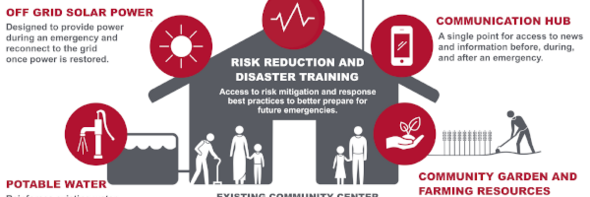Baltimore Community Resilience Hub
| Baltimore Community Resilience Hub | |
 Community Resilience Hub Diagram | |
| Team Organizations | CCRUN RISA |
| Point of Contact | Aubrey Germ |
| Participating Municipalities | Baltimore MD |
| Sectors | Public Safety |
| Initiative | |
| Status | Launched |
| Last Updated | December 5, 2025 |
Summary
Baltimore is highly vulnerable to a range of natural hazards, including coastal storms, flooding, extreme heat, and high winds. These types of extreme events are likely to increase in frequency and magnitude over the coming years. These natural hazards, combined with exacerbated influences of climate change, create impacts that will affect the City’s residents, businesses, infrastructure, and natural systems, and threaten regionally significant assets.
In 2013, the City of Baltimore developed an integrated All Hazards Mitigation Plan (AHMP) and Climate Adaptation Plan. This Plan, called the Disaster Preparedness and Planning Project (DP3), links research, outreach, and actions to create a comprehensive system for addressing existing and future climate impacts. The DP3 was approved by Planning Commission on October 3, 2013 and has served as the guiding document for all mitigation and resiliency implementation since November 2013. A FEMA-mandated 5-year update of the plan took place in 2018 and the 2018 DP3 Update was approved by FEMA and adopted by the Planning Commission on December 20, 2018. This is the guiding document for 2018-2023, until a 2023 Update is developed and adopted.
The DP3 outlines feasible and effective mitigation and adaptation recommendations for the below hazards, identified as posing the most significant threats for Baltimore:
- Flooding
- Coastal Hazards: Tropical Storms and Hurricanes, Nor’Easter, Sea Level Rise, and Storm Surge & Coastal Inundation
- Precipitation Variability: Precipitation, Winter Storms, Drought, Dam Failure
- Extreme Wind: Associated with Storms, Derechos, Tornados
- Additional Hazards: Earthquakes, Lightning and Hail, Tsunamis